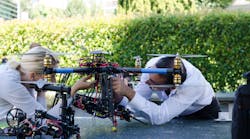The requirements for fifth-generation, or 5G, wireless are forming around technologies that until recently have never been connected to cellular networks. That automobile companies like Porsche and Ford attended this year's Mobile World Congress in Barcelona signaled that wireless carriers had chosen new services over smartphones as the main target for 5G technology.
That was underlined again last week, when Intel announced that it would cooperate with AT&T to test unmanned aerial vehicles (UAVs), or drones, using LTE networks. With the tests, both companies want to understand how reliable the high-speed wireless standard is for streaming live video and flight information—and in general, how it works with devices flying through the air.
Most consumer drones employ Wi-Fi, Bluetooth, and radio signals to send data over a relatively short distance. These networks typically connect drones to smartphones or tablets, which can be used to control and monitor flight paths.
“UAVs have great potential, from inspections [and] precision agriculture, to deliveries of consumer goods and providing emergency disaster relief,” said Anil Nanduri, vice president of Intel’s New Technology Group, in a statement. Their unique point of view has turned drones into a versatile tool for commercial companies like Skycatch, a startup that uses drones to map construction sites.
But once drones get out of range of Wi-Fi or radio signals, reliability becomes a serious concern—especially in situations like disaster relief or law enforcement. Both Intel and AT&T want to know whether the range and reliability of LTE can settle concerns like security, safety, and potential interference with manned aircraft.
Whether drones can access LTE networks will ultimately be subject to the approval of the Federal Communications Commission (FCC) and Federal Aviation Administration (FAA), both of which have enacted strict rules governing drone use. But successful tests could help ease concerns about autonomous drones employed for commercial uses, like Amazon’s plans for a drone shipping service.
Preliminary tests were held at this year's Mobile World Congress, where Intel demonstrated a Yuneec Typhoon drone equipped an AT&T sim card. The drone showed that it could stream live video and other data from the air using the carrier’s core LTE network. The drone also used a special module with Intel Realsense, a technology that Intel designed for human-computer interactions, but has since been adapted to help drones avoid collisions.
Intel has regarded drones as a symbol for the kind of technologies that will proliferate around 5G networks. Sensors, for instance, will be embedded in everything from cargo ship containers to parking spaces in a garage, transmitting data and sending it wirelessly. The major theme at Mobile World Congress was that while fourth-generation, or 4G, networks were designed to give smartphone users a better experience, 5G networks would be more focused on connecting machines.
AT&T has already begun to embrace this idea. The carrier has started giving businesses access to services like managing and storing data gathered by drones. Also known as M2X, the platform also extends to the industrial Internet of Things (IIoT), wearables, fleet management for trucking companies, and other industries that want automatic status reports on their equipment. AT&T is betting that 5G will make these kinds of services even more valuable.
